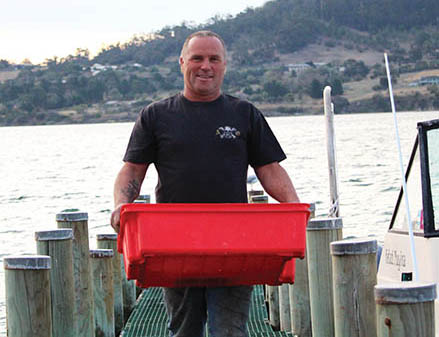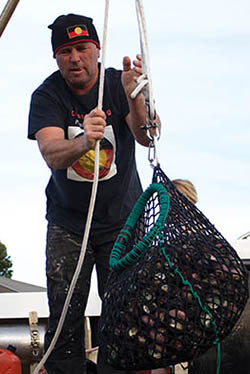Insight gained from Indigenous customs has changed Bryan Denny’s approach to commercial fishing and encouraged his efforts to share these perspectives
Story Catherine Norwood
Photos Robyn Denny
 Melurkedee man and commercial fisher Bryan Denny says taking the time to be involved in advisory committees is a way to ensure diverse perspectives are considered in decision-making processes.
Melurkedee man and commercial fisher Bryan Denny says taking the time to be involved in advisory committees is a way to ensure diverse perspectives are considered in decision-making processes.
The Tasmanian coastline is dotted with middens – ‘kitchen’ areas from thousands of years of settlement by Indigenous communities. For commercial fisher Bryan Denny, the middens provide a fascinating glimpse into the past, with shells, bones and other remnants offering information about the fishing practices and the diets of local people – his people.
Walking the beaches where the middens are sometimes hundreds of metres long, he has infused his observations into his own commercial fishing practice as it has developed over more than three decades. Bryan Denny has been diving for Periwinkles ever since he first walked out of school at age 15 with a fishing licence in his hand.
He is officially recognised as a Melurkedee man, from south-east Tasmania, although his fisheries experience is based mostly on Western techniques rather than traditional Indigenous practices, and he grew up at Dover, in the south-west of the state. His adoption of a more traditional approach to his fishing has happened gradually, he says, and by learning from his own experiences and mistakes.
He says when he first started fishing for Periwinkles there was no quota and no size limit on the species, and he had no real reference to traditional knowledge either.
Periwinkles are commonly found at the sandy edges of reefs, and in the gutters between rocky outcrops where the seaweed detritus collects. He says it was, and still is, a common practice to strip harvest most animals from a site. But there are areas that he harvested this way as a young man that even 30 years later have not recovered their Periwinkle populations.
New insight
 Bryan Denny with a catch of Periwinkles.
Bryan Denny with a catch of Periwinkles. His early years as a fisher also included time as a deckhand on rock lobster boats, which gave him new insight into other harvesting practices and also introduced him to the middens.
“We used to go ashore and walk around, looking at middens on the west coast, some of which extend for 500 metres to a kilometre along beaches “Without really realising it, I started to base my fishing practices on the size of the shells that you see in those middens. Subconsciously, you look at it and say, if the ancestors were eating a Periwinkle that big, why am I taking them smaller? It’s the same with abalone.”
The initial official size limit for Periwinkles in Tasmania was 30 millimetres, and then increased to 45 millimetres. “But I still don’t think that’s big enough,” Bryan Denny says. He targets Periwinkles 55 to 60 millimetres, or 105 to 110 grams, which he says is the ideal meal size. He estimates the animals are six or seven years old by the time he harvests them, and he sells them direct to select restaurants in Melbourne and Sydney.
Over the past 10 years he has adopted the practice of harvesting only two-thirds of the legal-size animals at each site he visits, and he leaves small satellite populations to build into a larger biomass. He is much more focused on maintaining the ability to fish into the future, rather than maximising yields today … although he cannot control what other fishers do.
With that in mind he is also active in contributing to discussions about fisheries management and how Indigenous Tasmanians can reconnect with and share their sea country.
In 2009 he undertook the FRDC’s National Seafood Industry Leadership Program, and since 2011 he has been a member of its Indigenous Reference Group (IRG). In March this year he joined an IRG study tour to New Zealand to learn more about how Indigenous communities across the Tasman had developed their fishing rights, and how they operate their fisheries.
As an Indigenous commercial fisher, Bryan Denny feels he brings a practical understanding of fisheries rules and regulations and their impact on fishing enterprises to the IRG, as well as links to Indigenous communities. It adds to the perspectives of the IRG, which includes government, policy, research and non-commercial Indigenous representation.
“The IRG’s aim is to get the best outcomes in research projects to help Indigenous communities enter different fishing enterprises. I think there are opportunities to build better relationships with government agencies, to get the right help, and to get some fisheries rights handed back to Indigenous fishers,” he says. “Australia wasn’t uninhabited when white settlers came; there were people here who used the land and the sea, and who traded their harvest.”
While the Periwinkle fishery is already established in Tasmania, it is still to be developed in other states. Periwinkle is known as ‘warrener’ in one of the Tasmanian Indigenous languages, although Bryan Denny says he’s not sure which one. In South Australia, it’s called ‘turbo’, and he has been working with the Narungga people there to explore the development of a Periwinkle fishery in SA.
“For any new fishery that is developed, if it was historically used as a food source for Indigenous people, there is some potential to help Indigenous people get into those fisheries and help develop those fisheries.”
In Tasmania, wild angasi Native Oysters and Blue Mussels might be possible options. But one of the state’s major hurdles, he says, is that many people think that there are no Aboriginal people in Tasmania, which is clearly not the case.
As a practical demonstration of both research and creating awareness of local Indigenous sea culture, he points to the FRDC-funded ‘Wave to Plate’ project conducted by Emma Lee, which included an Indigenous seafood dinner as part of the 2018 Dark Mofo festival (‘Seafood dining shares culture’, FISH, March 2019, pages 36–37).
“I think that project’s going to do a lot of good in actually getting people involved in the fishery. That is one of the issues – getting the projects we are supporting happening on the ground, not just getting a document at the end of it.”
Bryan Denny was recently re-elected as a director of the Tasmanian Seafood Industry Council and is currently vice-president. He is also a member of the Tasmania Research Advisory Council, which supports the research priorities and decision-making of the FRDC.
The committee meetings do take time away from his fishing. While his main focus is on the Periwinkles, he also operates in the Commonwealth shark fishery. If the weather is good enough he will be at sea – unless he is in a meeting. But the time he spends on these advisory committees is important to him too.
“I think it’s important to be involved and to have a say. All Indigenous people know they want something to be done, to recognise their rights, to address disadvantage in their communities. And there’s no point in fishers standing around a boat ramp whingeing about the state of the fishery either.
“You have to put your bum on a seat and stick your hand up and start telling people. You do have to be proactive. If you’ve got a passion, then make your voice heard so that other people might be able to pick up that same idea.
“Hearing people say ‘that’s not such a bad idea’, or ‘we never really thought of it like that’ – that’s really important,” he says.





